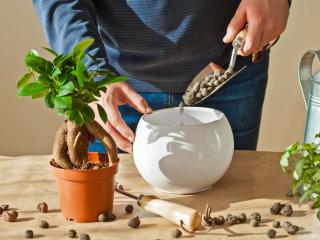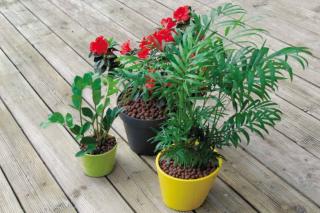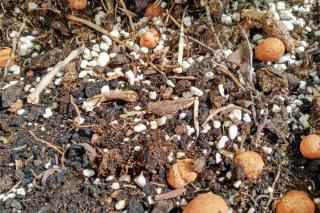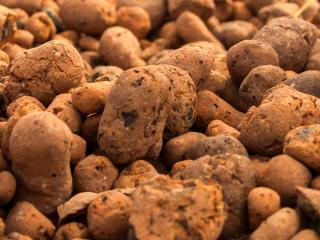

Clay pebbles, or leca, are brown balls of clay that are of great use to plants.
It has the advantage of reliably managing water for plants, and it lasts a long time.
Thanks to its 100% mineral content, clay balls are useful for drainage, repotting and also decoration!
→ Other names for this include clay balls, hydroton… LECA is an abbreviation of Lightweight Expanded Clay Aggregate.
Clay pebbles can be used in many manners, both ornamental and to enhance the living conditions of your potted plants.
 Drainage – All you need to do is pour a layer about an inch or two thick (3 to 4 centimeters) at the bottom of the container (pot, garden box, other) and this will increase air circulation, protect the roots and thus favor plant growth. Succulents, cactus and air plants can use nearly 100% clay pebbles as a growing medium.
Drainage – All you need to do is pour a layer about an inch or two thick (3 to 4 centimeters) at the bottom of the container (pot, garden box, other) and this will increase air circulation, protect the roots and thus favor plant growth. Succulents, cactus and air plants can use nearly 100% clay pebbles as a growing medium.
Clay pebbles can raise moisture levels from 40-50% relative humidity to a more comfortable 80 % moisture, see how here. Wet the clay beads with rainwater to keep the pores from stopping up due to excess minerals in tapwater.
This will protect many houseplants from getting brown leaf tips!

Together with hydrogel crystals, clay pebbles are a boon to help plants survive drought, or help young trees start off in their first few years!
Just as for repotting, mix in about 10% volume to the soil mix used for planting your tree.
Clay pebbles, per se, don’t really fertilize plants. But if you dunk them in a solution of home-made weed tea, they’ll pack a punch for weeks afterwards!
Once ready, spread them as mulch or add them to your pots and growing beds. In cases where the fertilizer mix smells somewhat, bury the leca balls into the potting soil for houseplants.

It’s produced by flash-heating up to 2000°F (1200°C), regular, slightly wet clay balls in a super-hot oven. Water evaporates instantly, forming tiny bubbles of vapor. Vapor and other gases inside expand to look like a sponge or honeycomb. These connect to let the pressure escape.
→ This happens naturally in volcanoes during eruptions. It explains why pumice and, to a point, pozzolan, is so light it can float!
In the end, the structure is like a sponge, with lots of tiny cavities to retain water, nutrients, and clay.
Clay balls also go by other names: aggregates, brown balls or clay pellets and beads, just to cite a few.
If you use this substrate for mulch, you’ll be avoiding water loss through evaporation and weed growth.
This will help reduce time spent in watering, and also avoid use of weed-killing chemicals and you’ll be doing your part for sustainable development.
I am decreasing the size of my aquiponic garden. i have a huge amont of hudroton clay pebbles and i want to know if i can use the clay pellets as mulch in my flower garden
Sure, it’s a great mulch to use! It’ll soak up water when it rains and store it for later for the plants.